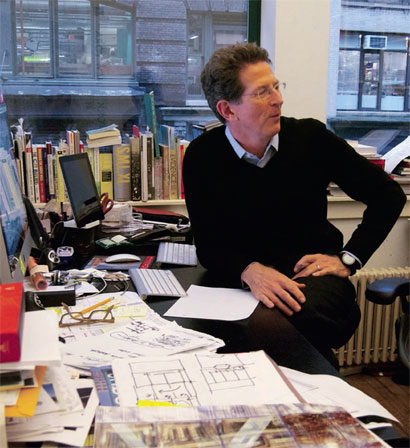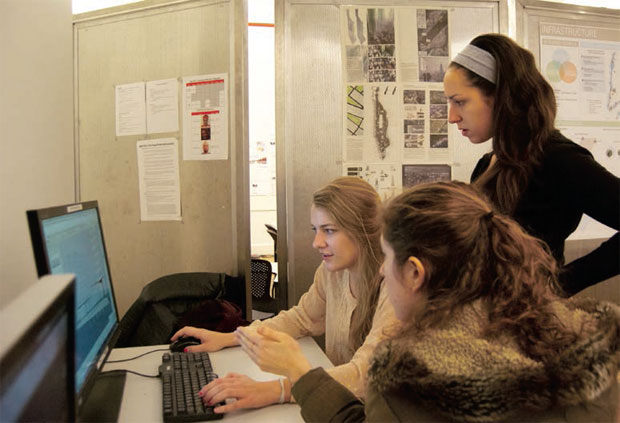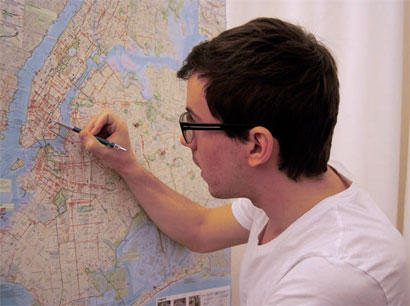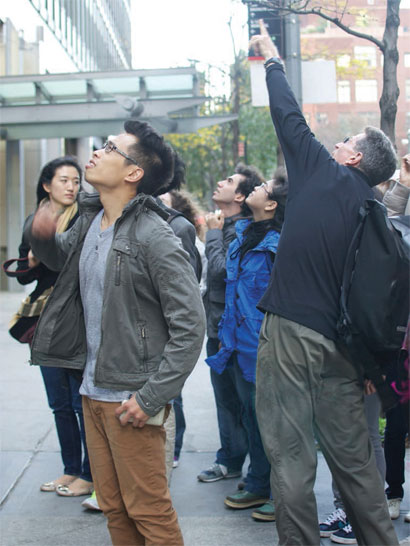On a drizzly Friday in early November, a class of Cornell students is gathered around a conference table at a hip architectural rendering firm in New York’s Greenwich Village. Down the hall, workers at tomato-red, industrial-style metal desks are creating startlingly lifelike images on broad computer screens. Just outside the door a photo shoot is in progress, its intense flashes repeatedly stunning the students along one side of the table.
On the wall, next to the firm’s Emmy statuette, is a flatscreen TV displaying images the students took for the class on architectural rendering—a field that, over the past decade or so, has segued from handmade models to computer-generated imagery. Their assignment: to photograph a location and manipulate the images to create works in the style of two renowned photographers—Philip-Lorca DiCorcia, whose seemingly spontaneous street scenes are painstakingly crafted, and Oliver Boberg, who photographs dioramas that come across as amazingly lifelike settings.
After a discussion of a classmate’s shots of a construction site, it’s Vicki Long’s turn to be critiqued. The instructor—the firm’s art director, Mike Golden—puts Long’s two images of a parking garage up on the screen. One version includes a bright orange traffic cone that’s absent in the other, one of several differences between the two. “The cone is actually great,” Golden says. “It gives a focal point to the image.”

Tour de NYC: Planning student Max Taffet commutes daily from Crown Heights, Brooklyn, to the AAP studio in Chelsea.
Long, a second-year master’s student in urban planning, points out a set of surveillance cameras that’s more visible in one image than the other, and the class debates their merits. “The Boberg one, I think, is rather successful,” Golden says finally. “It’s busier than Boberg’s work, but the idea wasn’t just to mimic it.”
Getting such hands-on feedback from a pro at the vanguard of the city’s design scene is the sort of thing that most students only dream of—but it’s just another day for Long and her classmates, all students in the College of Architecture, Art, and Planning’s New York program. Dubbed AAP NYC, the program brings more than 100 undergrads and grad students to the city annually for an intense period of work and study, either for a semester or a summer. “The center of the architectural world really resides in two or three large, international locations—New York being probably tied with London,” says Bob Balder ’89, the program’s executive director. “So in terms of professional development, New York is the obvious choice. Given its close proximity to Ithaca, it’s a natural fit. It’s a fabulous way for Cornell to have it both ways.”
Founded in 2006, AAP NYC is one of several University programs in the city, which has become an increasingly important part of the Cornell experience. The Medical College has been in Manhattan for more than a century, of course, and the University is in the process of designing a multi-billion-dollar tech campus on Roosevelt Island. City-based programs—some for traditional students, others geared toward mid-career professionals—also include offerings in human ecology, business, and ILR. “I love the urban landscape and the diversity that you have in New York City,” says Long, a Toronto native who ultimately aims to bring her planning skills back to her hometown. “Life in New York is fascinating in and of itself. There are always new exhibits relating to urban infrastructure or urbanism in general, and the arts scene is great. It provides a great background for the studies we’re doing, because we’re not limited to reading reports or professional research. We’re able to see how it actually works in practice.”
AAP NYC is housed—at least for now—in a former garment-industry loft on West 17th Street in Chelsea. The 5,000-square-foot space feels like the home of a scrappy start-up: open floorplan; large industrial-style windows; clusters of desks made of hollow-core doors slung across orange sawhorses; tech-savvy twenty-somethings hunched over computers or working in groups late into the night, papers and drawings spread out on every surface. But as of next fall, the program will no longer call this space home. Balder and his colleagues are searching for a new location, prompted by a rent increase and a desire for more square footage and expanded enrollment; a city map on one wall of his office is dotted with more than 100 purple pushpins denoting spaces he’s visited.

Close quarters: AAP NYC executive director Bob Balder ’89 is looking for the program’s next home, with room for more students.
By leaving their current spot, the program also sought to escape a quintessentially urban menace: ear-splitting noise. Until last summer, the tenant directly beneath the AAP NYC space was Splash Bar, a wildly popular gay nightclub—and, like the notoriously busy students, the partiers kept vampire’s hours. When the program held special events, they’d have to end by 8:30 or 9:00, lest the music drown out the speakers. “The impact of the club on the studio was pretty intense,” Balder says with a rueful laugh. “The whole floor would shake. The sound system was right underneath us, hanging off the floor. I could feel the shockwave at my desk. There would be a mob outside the window—black cars, taxis, all the people getting dropped off. You’d have this party underneath you seven nights a week until four in the morning. Some students could put headphones on and work through anything, but for some it was quite unpleasant.” (The bar closed in August, after the program had already decided to move.)
The AAP NYC experience is a combination of coursework and paid internships, interspersed with regular field trips around the city. Sojourns have included bike tours of the waterfront and of an old waterworks in Queens; a visit to the Lower East Side (including a look inside a historic apartment building and a snack stop at Essex Market); and a boat trip that comprised everything from Superfund sites to the Statue of Liberty. In October, Master of Regional Planning (MRP) students in an infrastructure technology class taught by John An ’97, BArch ’00, visited a site way off the usual tourist route: a state-of-the-art wastewater treatment facility in the basement of a condominium in Battery Park City. “The expert who designed the system talked to them and they took a detailed tour,” says An, a senior director at a sustainability and energy-management consulting firm in the city. “Having that direct connection between the topic area being discussed, and being able to go see the technology in action, makes a big impact on the students.”
Such outings underscore an inherent limitation of Cornell’s location on a hill above a lake: it’s not always easy to learn urban planning hundreds of miles from a major city, or to train in architecture far from marquee buildings and centers of the profession, or to study art far from world-class galleries and major museums. “We use the city as a learning laboratory,” says Balder, who previously worked for New York’s Economic Development Corporation under three mayors. “Because there are so many offerings here, we don’t have to produce everything ourselves—as opposed to Ithaca, where you’re largely recruiting people to come lecture, be involved in a special event, or curate an exhibition. It’s also a unique opportunity for us to tap into people who may not have enough time to come to Ithaca. We can integrate them here in a way that’s much more manageable to them.”
That sentiment is writ large earlier on that same Friday, when Scott Lee ’92, ME ’93, a principal with Morphosis Architects, meets with students in AAP NYC’s only enclosed classroom. In a course known as a design studio, the students are working on a master plan for the Cornell Tech campus—and Morphosis is the project’s architectural firm. So, in addition to visiting Roosevelt Island (which is located in the East River between two boroughs), the students have their work painstakingly critiqued by one of the project’s leaders. “It makes a huge difference that we’re actually in New York City being able to experience the difference between Manhattan and Queens,” fifth-year architecture student Mary Bray Erickson says afterward. “It was pretty cool to be able to do that firsthand.”

Fifth-year architects (from left) Mary Bray Erickson, Lillian Simon, and Sarah Schwartz.
A resident of Winston-Salem, North Carolina, Erickson is working on the project on a team with two close friends, fellow fifth-years Lillian Simon and Sarah Schwartz. The three were roommates last year in AAP’s Cornell in Rome program. “I think this a great second abroad experience,” says Schwartz, of Horsham, Pennsylvania. “It’s great that we saw something in Europe that’s completely different from the U.S., but then it’s great to have the New York program because we’re getting outside the school bubble and we’re immersed in the city. It feels like architecture has a more practical implication here, versus in Ithaca where it can sometimes feel theoretical.” Like most AAP NYC students, Simon interns two days a week. Her work for the major architectural and engineering firm Skidmore, Owings & Merrill has included building models, drawing diagrams, and coloring plans. “They’ve done a great job integrating me and using me,” says Simon, of Newton, Massachusetts. “It’s been a month, and I’ve learned so much about the process of real-world architecture, the way the business works. In school we don’t get past the design phase into real life; it always ends at a certain point.”

MRP student Dan Moran at work.
In contrast to design studios—which are more theoretical and academic—workshops are built around projects for real-world clients, with the students in the role of unpaid consultants. Second-year MRP candidate Max Taffet is working on one such effort, studying the potential for technological and cultural enterprise zones in the neighborhood around the Noguchi Museum in Queens. The area is seeing growth and change due to the museum and other factors—and in future decades, it could be the site of start-ups overflowing from Cornell Tech across the river. “My group probably spent twenty hours studying building quality in the space around the museum over the course of a month,” says Taffet, who comes from Boulder and holds an undergrad degree from the University of British Columbia, Vancouver. “Just being in a random warehouse district that you’d otherwise have no reason to be in, you begin to see things differently.”
Like a number of AAP NYC students, Taffet lives in Brooklyn—for many, the borough offers the right balance of proximity, affordability, and hipness—and bikes to school daily, a thirty-minute trip each way. (He and three classmates share the top floor of a brownstone in Crown Heights—the same neighborhood his forbears lived in after escaping pogroms in Eastern Europe.) Balder, too, is an avid biker, and numerous pedagogical outings have been conducted on two wheels. “New York City is big, but with a bike it shrinks very quickly,” says Taffet, who’s interning with the city’s Economic Development Corporation as well as serving as AAP NYC’s official blogger. “I feel like the subway is this magic thing where you just pop up places, and the transitions aren’t very clear. But with a bike, you’re seeing a neighborhood as it changes, as different populations show up, as the buildings get nicer or less nice. For our workshop, it’s kind of a straight shot through Bed-Stuy and Greenpoint to Astoria. Seeing these classic Brooklyn pockets and then going through these incredible high-rise districts that are growing from scratch as the result of new zoning codes, and then arriving at our site where we’re looking at the implications of a new zoning project—the bike allows you to see that in its regional context.”
Across the room, fellow MRP second-year Dan Moran is working on an urban design studio project on revitalizing the Lower East Side waterfront—an area dominated by a massive Con Ed power plant that flooded during Hurricane Sandy. Armed with a stack of rainbow-hued Sharpies, Moran is color-coding a diagram of various transit methods including bike paths, pedestrian walkways, bus routes, and subway lines.

Living lab: Balder leads students on one of many excursions.
A Boston native and graduate of Skidmore College, Moran is interning at the Port Authority, working on one of its highest-profile projects: the reimagining of the neighborhood surrounding Penn Station and Madison Square Garden, which includes the transformation of a grand post office into a new rail station. “Penn Station is at total capacity, it’s an underground maze, and it’s generally hated by everyone who uses it or has to look at it,” Moran notes. “Madison Square Garden is ugly and crowded and the district surrounding it is not very pleasant. There’s low-end shopping, which is not inherently bad—but considering that it’s the busiest transit hub in the Western Hemisphere, there’s not as much value surrounding it as there could be.” For research, Moran pounded the pavement inside the station and in the surrounding neighborhood, identifying “soft sites” for potential demolition and redevelopment. “I look at it all as value added,” Moran says of his urban semester. “Every time I walk down the street I think of it as experience added to my playbook. In New York, I’ve been able to get my head in the game.”
On top of their coursework, internships, and field trips, AAP NYC students can tap into the many professional organizations that have presences in the city, such as the Center for Architecture and the American Planning Association. In October, future planners attended a two-day conference at the Municipal Arts Society, where speakers addressed topics ranging from historic preservation to disaster resiliency. They also benefit from mentorship and networking for future jobs. Engineering alum Jim Greenberg ’68, a principal with the international architecture firm Perkins Eastman and one of the program’s faculty, has hired AAP NYC graduates into its New York, Boston, and San Francisco offices. He notes that he wishes that the course he co-teaches—the required class on professional practice—had been offered when he earned his master’s in architecture at Penn. “Our emphasis is on preparing people for what you need to know if you want to go out on your own,” he says. “Architectural education is strongly focused on design—which is very important, but it’s something that many architects aren’t involved with in most of their career. If you look at the fee structure, only a third is spent on design and two-thirds is spent on technical and administrative aspects.”
Another, more esoteric benefit of AAP NYC is cross-pollination with other disciplines. While architects and planners may be more isolated in their own programs back on campus, in New York they’re working elbow to elbow; a view over someone’s shoulder can spark the sort of “creative collision” prized in the modern workplace. “It’s dynamic, because you’re constantly in contact with others,” says Long. “You’re never alone; there’s a lot of group work. You’re always having that ricochet of thoughts and ideas. You definitely go through periods of exhaustion because you absorb so much information. But in the end, I think that process will reveal something really worthwhile.”
Photographs by Vicki Long


